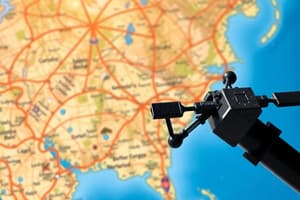Podcast
Questions and Answers
What is the primary function of Differential GPS?
What is the primary function of Differential GPS?
- To reduce the effect of multipath interference
- To increase the number of satellites in view
- To increase the signal strength of GPS signals
- To improve the accuracy and correct bias errors at one location (correct)
What type of errors are corrected in Differential GPS?
What type of errors are corrected in Differential GPS?
- Ionosphere and troposphere delays, receiver noise and multipath
- Satellite clock and orbit errors, receiver noise and multipath
- Multipath, receiver noise and atmospheric delays
- Satellite clock differences, ephemeris errors and atmospheric delays (correct)
What is the main effect of increasing age or latency of corrections on DGPS?
What is the main effect of increasing age or latency of corrections on DGPS?
- Increase in accuracy
- No effect on accuracy
- Decrease in accuracy (correct)
- Increase in satellite visibility
What is the typical error increase in DGPS per 100 km of separation distance?
What is the typical error increase in DGPS per 100 km of separation distance?
What is the main advantage of using Differential GPS?
What is the main advantage of using Differential GPS?
What is the typical maximum separation distance recommended for DGPS?
What is the typical maximum separation distance recommended for DGPS?
What is the primary purpose of the GPS receiver obtaining signals from at least four satellites?
What is the primary purpose of the GPS receiver obtaining signals from at least four satellites?
What is the term for the measured propagation time delay between the satellite and the receiver?
What is the term for the measured propagation time delay between the satellite and the receiver?
What is the purpose of the ephemeris data in GPS calculations?
What is the purpose of the ephemeris data in GPS calculations?
What is the term for the error in the measured range due to the receiver's clock bias?
What is the term for the error in the measured range due to the receiver's clock bias?
What is the purpose of the fourth satellite in GPS calculations?
What is the purpose of the fourth satellite in GPS calculations?
What is the frequency of the L1 carrier signal in GPS?
What is the frequency of the L1 carrier signal in GPS?
What is the purpose of the Coarse/Acquisition (C/A) code in GPS?
What is the purpose of the Coarse/Acquisition (C/A) code in GPS?
What is the term for the process of determining the satellite's position using ephemeris data?
What is the term for the process of determining the satellite's position using ephemeris data?
What is the purpose of the GPS receiver's clock bias calculation?
What is the purpose of the GPS receiver's clock bias calculation?
What is the term for the calculation of the receiver's position using ranging equations?
What is the term for the calculation of the receiver's position using ranging equations?
What is the primary factor that determines the Dilution of Precision (DOP) in GPS receiver calculations?
What is the primary factor that determines the Dilution of Precision (DOP) in GPS receiver calculations?
What is the result of good geometric DOP in GPS receiver calculations?
What is the result of good geometric DOP in GPS receiver calculations?
What is the primary purpose of Differential GPS (DGPS) in precision GPS applications?
What is the primary purpose of Differential GPS (DGPS) in precision GPS applications?
What is the effect of bad visibility on GPS receiver calculations, even with good GDOP?
What is the effect of bad visibility on GPS receiver calculations, even with good GDOP?
What is the role of reference stations in Differential GPS (DGPS) applications?
What is the role of reference stations in Differential GPS (DGPS) applications?
What is the benefit of using multiple satellites in GPS receiver calculations?
What is the benefit of using multiple satellites in GPS receiver calculations?
What is the effect of satellite geometry on GPS receiver calculations?
What is the effect of satellite geometry on GPS receiver calculations?
What is the purpose of the broadcast corrections in Differential GPS (DGPS) applications?
What is the purpose of the broadcast corrections in Differential GPS (DGPS) applications?
Flashcards are hidden until you start studying
Study Notes
GPS System Overview
- GPS receivers use radio signals from satellites to calculate their current position and speed/direction
- The system requires a minimum of three satellites in view to provide a location solution
How GPS Works
- A GPS receiver measures the time delay between when a signal is sent and when it is received to calculate the distance from the satellite
- The distance is calculated by multiplying the time delay by the speed of light
- The receiver uses the intersection of three or more spheres (one for each satellite) to determine its location
GPS Timing Solution
- GPS satellites have highly accurate atomic clocks, which provide GPS time
- Civilian GPS receivers have less accurate quartz clocks, which require synchronization with GPS time
- The receiver clock bias is calculated using a fourth satellite signal, which provides a fourth equation to solve for the clock bias
Navigation Solution
- The navigation solution provides the user's location in three-dimensional space (x, y, z)
- The solution requires a minimum of four satellites in view to determine the user's location and clock bias
GPS Signal Structure
- GPS satellites transmit two carrier frequencies: L1 (1.57542 GHz) and L2 (1.22760 GHz)
- Each satellite transmits two distinct spread spectrum codes: C/A (coarse/acquisition) and P (precise) codes
Geometric Errors (DOP)
- The accuracy of a GPS location is affected by the geometric configuration of the satellites in view
- A good geometric configuration provides a low DOP (dilution of precision) factor, while a bad configuration results in a high DOP
Differential GPS (DGPS)
- DGPS provides sub-meter accuracy by using reference stations to calculate and broadcast corrections for various error sources
- Corrections are used to correct pseudorange, satellite ephemeris, clock offsets, and propagation errors due to ionospheric and tropospheric effects
Error Sources in GPS
- Typical error sources in GPS include satellite clock errors, orbit errors, ionospheric and tropospheric delays, receiver noise, and multipath effects
- DGPS can correct for most of these errors, except for multipath effects and receiver noise
DGPS Errors
- DGPS errors increase with the age of the corrections and the distance between the reference station and user
- Errors can be minimized by using corrections within 10s and separation distances within 50 km
Studying That Suits You
Use AI to generate personalized quizzes and flashcards to suit your learning preferences.




